This Lagman recipe is for a flavorful noodle soup from Central Asia. The aromatic broth is filled with vegetables and beef strips.
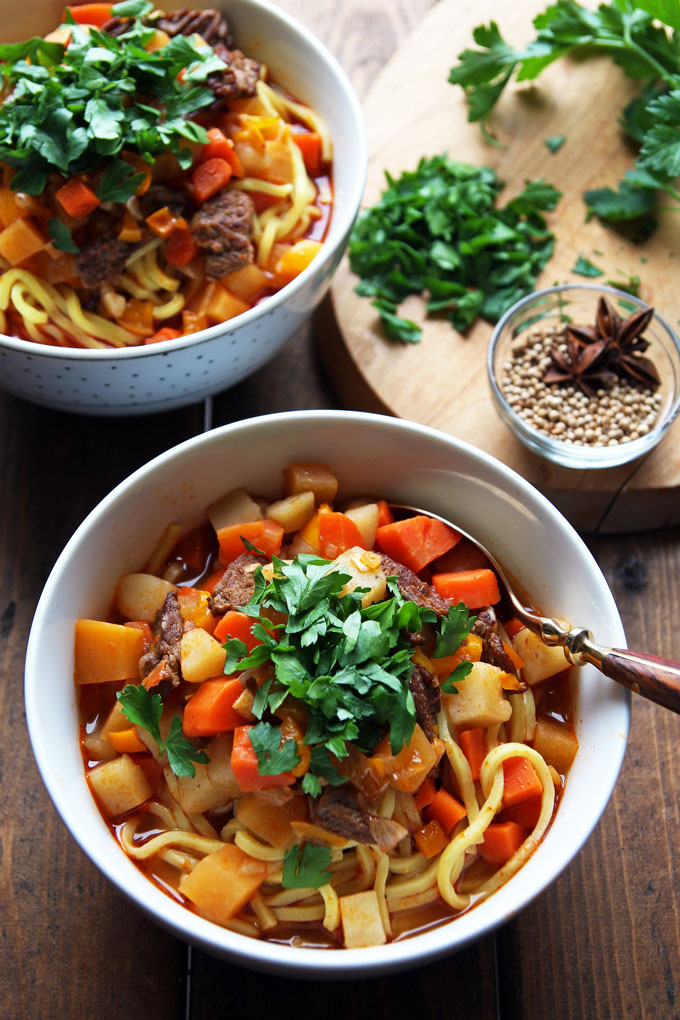
These are my absolute favorite posts, when I get to share with you a traditional recipe that I ate growing up. My mom usually cooks these meals off the top of her head, so it is very exciting to me being able to put measurements to these recipes, so I and everyone else can recreate them.
However, this is also a little intimidating. These recipes are authentic to me, because this is the way I grew up eating them. But I also realize that someone having grown up with a similar food tradition may feel these recipes aren't authentic at all, because they deviate from their family recipe. Though I hope we can all embrace each others food love, even in its differences.
My mom was born and grew up in the Central Asian part of Russia. Lagman is a flavorful veggie noodle soup that is eaten in a number of countries from Uzbekistan and Kyrgyzstan to Turkmenistan. Wikipedia says it is originally Uyghur - an ethnic minority group of the region.

Making Lagman the Family Way with Fresh Noodles and Bone Broth
In research for this Lagman recipe, I observed and took notes while my mom was cooking. I also found a cookbook of traditional Soviet recipes on her shelf. And then there is, of course, the interwebs with its endless stream of information.
It seems that lamb is usually used in Lagman, but beef is a common substitute. Traditionally, the noodles are handmade in a unique way of pulling the dough. I found this cool video here. But I always grew up with spaghetti, linguine or fettucine in Lagman. Fresh dough noodles are better than dry pasta.
When I set out to make Lagman by myself for the very first time, I found these fresh Chinese noodles in my grocery store, and figured they would be as close as I could come to homemade noodles. I think, even fresh Udon noodles will work. For the meat portion of this soup, use a cut with bone. Cooking the bone makes for such a flavorful broth.
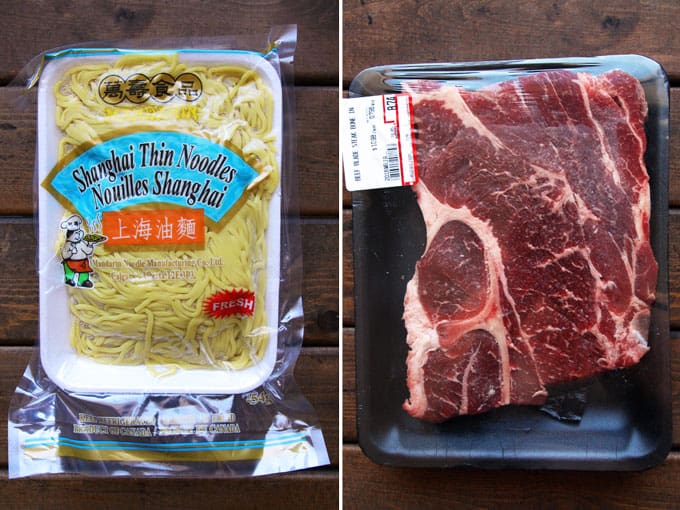
Nearly Any Vegetable Can Be Used in Lagman
The specific vegetables for the soup seemed to be different in every single recipe I found. We always use carrots, potatoes, bell pepper, tomatoes and rutabaga. My mom says the rutabaga is just a substitute for a root vegetable that is very specific to Central Asia and usually found in Lagman.
I've seen others use turnip, daikon or even a bunch of little radishes instead. The rutabaga makes for a sweeter soup as opposed to a radish-like veggie. Additionally, others also use celery, eggplant and whatever other vegetable they might have on hand. This really isn't a strict recipe. Coriander seeds and star anise are the stars that flavor the broth.
The noodles are cooked separately, then placed in a deep bowl and topped with the vegetables and beef and as much broth as desired. Some like it drier, while others (like my husband Konrad) like a LOT of broth when eating soup.
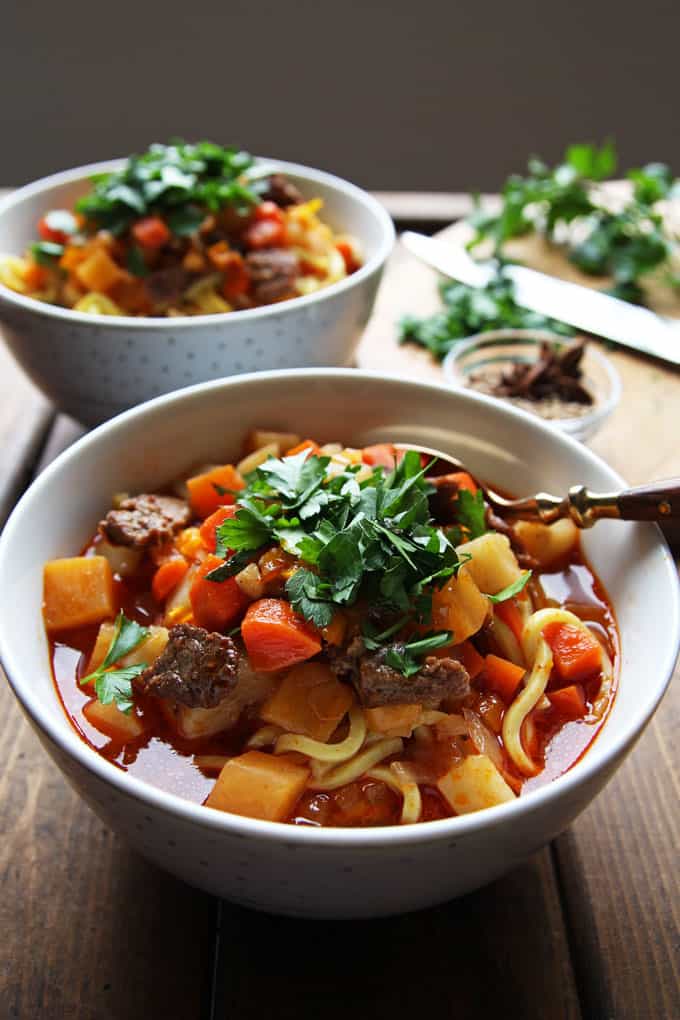
Top Off the Finished Lagman with Herbs and Serve!
Traditionally a bowl of Lagman is served with a bunch of chopped cilantro, fresh minced garlic and fresh chili slices.
To adapt it to our preference, I add the garlic and some chili flakes while cooking the soup. And since neither Konrad and I seem to be born with the cilantro-liking gene, some coarsely chopped flat leaf parsley makes a good stand-in.
I hope that even if you didn't grow up with Central Asian food influences, you'll give this delicious, aromatic and filling Noodle Beef Veggie Lagman soup a try. I know you will not regret it!
Recipe
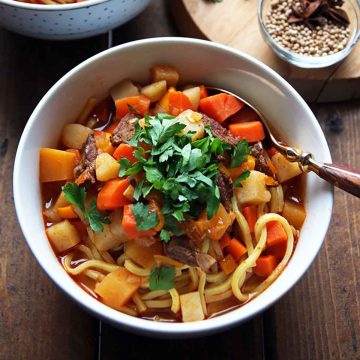
Lagman Recipe - Uzbek Beef Noodle Soup with Vegetables
Ingredients
- 1 pound beef cut into small strips (don't discard any bones)
- ¼ cup cooking oil
- 1 large onion chopped
- 3 garlic cloves minced
- 2 large carrots diced
- 2 medium potatoes diced
- 1 cup rutabaga diced; turnip or daikon
- 1 bell pepper diced
- 2 tomatoes diced or 1 cup canned tomatoes
- 1.5 tablespoons sea salt
- 1 teaspoon paprika powder
- 1 teaspoon coriander seeds
- 1 teaspoon freshly ground black pepper
- ½ teaspoon chili flakes
- 2 star anise pods
- 3 quarts hot water
- 1 pound fresh noodles
- cilantro or parsley for garnish
Instructions
- In a large soup pot with heavy bottom heat the oil on medium-high heat. Add the beef strips and cook uncovered for about 5 minutes until browned from all sides. Add onion and garlic to the pot and cook on medium until soft.
- Add the other vegetables and saute for a few minutes. Add any existing bone and spices (star anise and coriander seeds in a spice bag for easy removal) and fill hot/boiling water into the pot. Bring to a boil, then turn heat to low and simmer for about 40 minutes until meat is tender and vegetables are soft.
- Remove any bones and spice bag.
- Cook the noodles separately according to directions. Fill cooked noodles into deep bowls, top with soup and add coarsely chopped cilantro or parsley on top.
Notes
Pin Lagman Recipe for later?
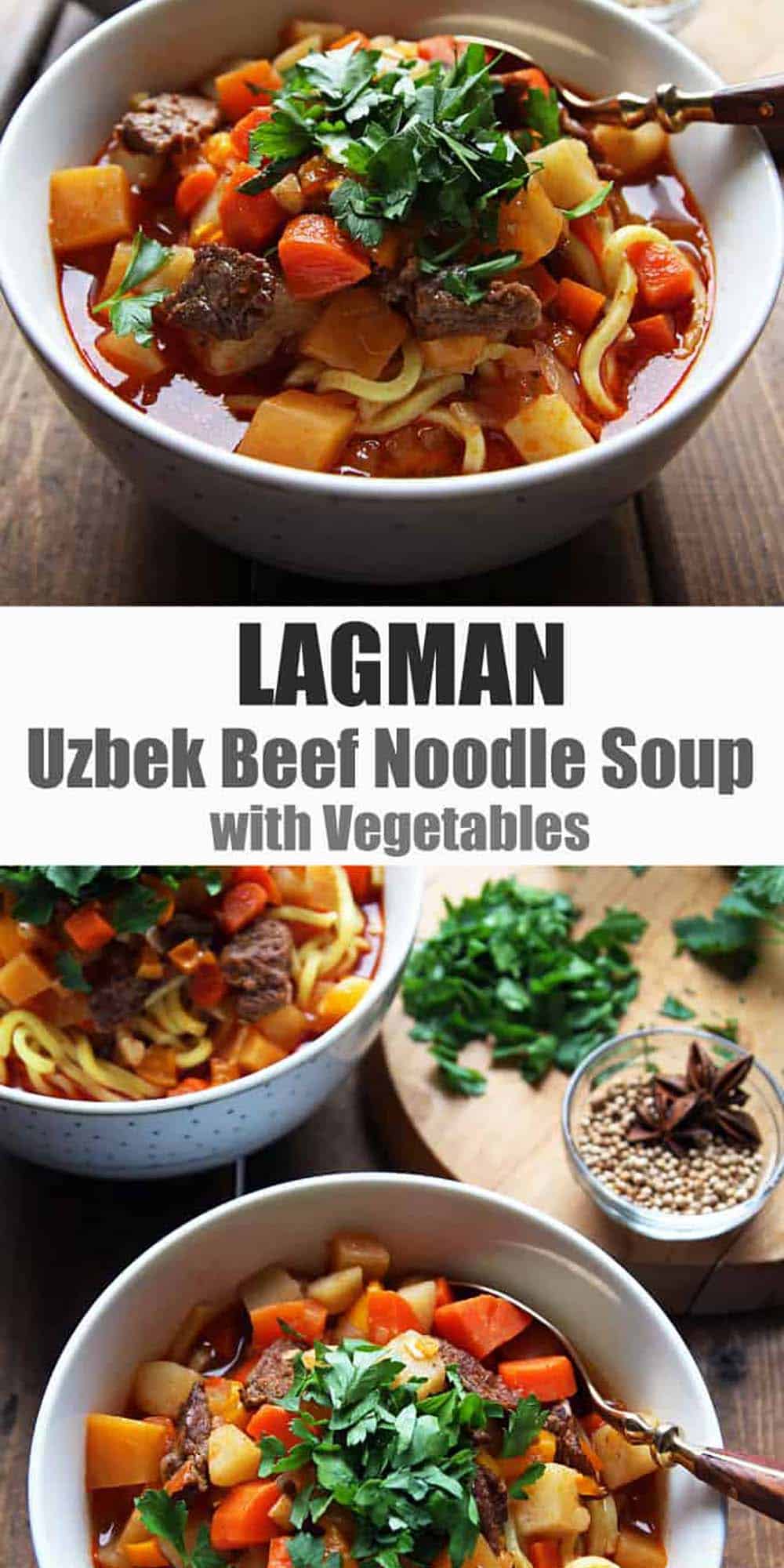
Products Used in this Lagman Recipe
Other Russian Recipes
For more recipes with Russian/Soviet background, check out:
- Uzbek Plov
- Ukrainian Borscht
- Russian Beet Salad
- Poppy Seed Sweet Rolls
- Instant Pot Rice Pilaf - Beef Plov
Random Questions
Lagman typically consists of flavorful broth, vegetables, and strips of beef. The specific ingredients can vary, but it commonly includes carrots, potatoes, bell peppers, tomatoes, and rutabaga. The broth is often flavored with coriander seeds and star anise.
There are various types of Lagman, with different regional variations and ingredient choices. Some use lamb instead of beef, while others incorporate different vegetables such as turnips, daikon, or eggplant. The types can differ based on the specific cultural influences and preferences.
Lagman is believed to have originated from the Uyghur ethnic minority group in Central Asia. It is a traditional dish commonly found in countries such as Uzbekistan, Kyrgyzstan, and Turkmenistan. Over time, it has spread to different regions, each adding its unique twist to the recipe.
The calorie count of Lagman can vary based on the specific ingredients and portion sizes used in the recipe. It typically consists of vegetables, beef, and noodles, making it a hearty and satisfying dish. However, the precise calorie count can depend on the preparation and serving size.





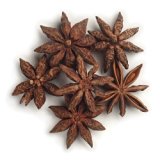
Sam
Hi! Making this on Monday for the first time. I was wondering if there was a benefit to using water and using the beef bones to create the broth over using a beef bone broth with boneless beef.
Let me know what you think!
Jennifer @ Leelalicious
Hi Sam! Both should work quite well in this recipe. Beef bones are great to use for making broth but the broth would take longer to make than if you used pre-made beef bone broth and boneless beef as it would take longer to extract all the flavours from the bones and it takes less time to extract flavour from pure beef. Beef bones have more collagen and minerals in them than the pure beef but I imagine that the store-bought beef bone broth would be quite similar in nutrient density. Either way should give you good results with this recipe but let us know if you have any other questions.
Katherine
I lived in Tashkent in 2017 as an ESL teacher. One day we made a trip into the mountains and we stopped for Lagman after a day playing in the snow and walking. It was one of the best meals I have ever had! This recipe brought me very close to that meal - the only thing missing was the famous freshly baked Uzbek non bread! Thank you so much! Going to try your plov recipe next 🙂 This Lagman will be a staple in our house whenever we want a comfort food for a cold night! Simply delicious.
Jennifer @ Leelalicious
Thank you for your lovely comment, Katherine, and for sharing your wonderful memory of eating Lagman on a winter day. 🙂
audrey
Thanks for sharing the recipe. Central Asia is NOT part of Russia, never been, it was under Russian hegemony and part of the Soviet Union.
Alla Osi
So so so good!! Just made it for the first time for my husband to try and he’s obsessed. Asked me if we can give some to his parents and then his brother 🙂
Unfortunately I didn’t find the star anise at the store but this recipe still turned out great! Thank you.
Øystein
Thanks for sharing your recipe! Just made this, and it turned out great:)
Regina
So glad you enjoyed it!
Ruth Grass
Google search brought me to your site 🙂 my lagman after your recipe is just boiling and it smells and looks amazing! Thanks for sharing the recipe.
Liebe Grüße
Regina
Hallo Ruth, wie toll dass du durch Google hierher gefunden hast. Ich hoffe du und deine Familie haben den Lagman genossen!
Dariga
Hi Regina,
This is a great recipe and it does look and smell like lagman in any of Central Asian countries! However, can I offer a small change? Lagman is a national dish of Uyghur people, an ethnicity whose representatives live in China, Kazakhstan, Uzbekistan, Kyrgyzstan, etc., not quite Uzbek people as the title suggests. I think it's fair to give Uyghur people their well-deserved credit for this amazing dish!
Jess @ whatjessicabakednext
Love this recipe, Regina! Noodle soups are my favourite - this looks so warming and comforting!
Regina
You are so right, Jessica. This soup is pure comfort!
Lena
Hi, Regina!
I already tried a few of your sweet recipes which all turned out great, thank you for that 🙂
But with this post I actually want to thank you for all those great recipes from my country of origin - plov, borsch, lagman... Being born in Uzbekistan, raised by russian parents and brought to Germany in the beginning teens, it is so sweet memories and always my very favourite food when my mum asks me what she should cook when I'll come to visit her. I find it very necessary to introduce more people to this faboulous cuisine and you are perfect for this job!
Many many thanks and maybe you will go with pelmeni or some piroshki in the near future 😉
lots of love :)))
Regina
Oh Lena, you have no idea how much your comment means to me!! Thank you!!
I am so happy to hear you already enjoyed some of my recipes. It sounds like we have a very similar food culture. I was born in Russia (Caucasus), raised in Germany and live in Canada now 😉 Your encouragement for these traditional recipes we both grew up with means the world. And I'll definitely keep pelmeni and piroshki in mind for future recipes 😀